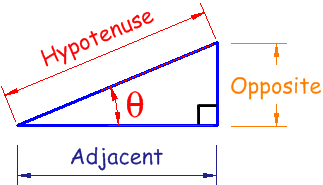Background
Animate approaching planets, as per a journey though the Solar System. At a distance of 2 Blender units, a sphere fills the entire height of the camera's view port:

This generates the following image:

Units, Measures, and Distances
The sphere is 4879.4 km in diameter, or 1 Blender unit.
The camera's final position is 9758.8 km from the planet, or 2 Blender units.
The camera's start position is 45999102.0 km from the planet, which is too many Blender units (9427.2).
Problem
Scale the planet's radius to simulate how it would appear at a given distance from the camera.
Progress
The angular diameter of the object can be calculated using:
$δ = 2 \times arctan( r / D )$
Where:
- δ is the angular diameter;
- r is the radius; and
- D is the distance.

Plugging the numbers:
δ = 2 arctan( 2439.70 / 45999102 )
= 0.0001060759 radians
Update #1
I think I can use the following:

The distance to the camera (adjacent side) is 9758.8 km.
Since $tan(δ) = opposite \over adjacent$, then $opposite = adjacent \times tan(δ)$. Thus
o = 9758.8 km tan( δ )
= 9758.8 km tan( 0.0001060759 )
= 1.035 km
Update #2
So at a distance of 45999102 km, the apparent size of a sphere with a 2439.70 km diameter would be 1.035 km at a distance of 9758.8 km.
Since 1 Blender unit = 4879.4 km, it follows that the sphere should have a radius of 0.000212116 Blender units, which is completely invisible.
Questions
- Have I gone astray?
- What would be the best approach to calculate the appropriate scaling factor for the sphere's radius (in Blender units)?
Solution
Using Henry's answer yields:
- Planet radius, $r_p = 2439.7 km$
- Planet distance, $D_p = 45999102 km$
- Blender distance, $D_b = r_p \times 4 = 9758.8 km$
- Apparent diameter: $2r \sqrt{ 1 – r^2 / D^2 }$
- Apparent distance: $D − r^2 / D$
- Scale factor: $Simulated\space apparent\space diameter \over Simulated\space apparent\space distance$ $\div$ $Blender\space apparent\space diameter \over Blender\space apparent\space distance$
Simulated apparent diameter = $2 \times 2439.7 \times \sqrt{ 1 – 2439.7^2 \over 45999102^2 }$ = $4879.40 km$
Simulated apparent distance = $45999102 – 2439.7^2 \over 45999102$ = $45999101.87 km$
Blender apparent diameter = $2 \times 2439.7 \times \sqrt{ 1 – 2439.7^2 \over 9758.8^2 }$ = $4724.46 km$
Blender apparent distance = $9758.8 – 2439.7^2 \over 9758.8$ = $3659.55 km$
$\therefore$ Scale factor = $4879.40 \over 45999101.87$ $\div$ $4724.46 \over 3659.55$ $\approx .0000821660$
Thank you!
Best Answer
I would have thought you should have
δ = 2 arcsin( r / D )which would mean that as the camera approaches the surface of the planet, $\delta$ would approach $\pi$.I assume you know how to draw a circular disk of diameter $2r$ a distance $D$ away in your animation system. As the camera gets closer to the (centre of the) planet, the apparent disk will seem to have a diameter of
2 r cos( δ / 2 )and be a distance away ofD - r sin( δ / 2 ).You can avoid the trigonometric functions by using an apparent diameter of $2 r \sqrt{1-r^2/D^2}$ and an apparent distance of $D - r^2/D$.